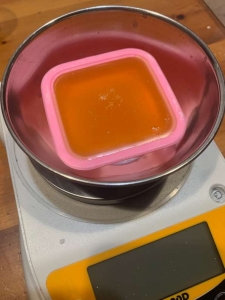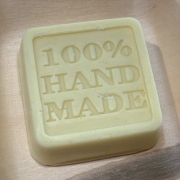Get your work space ready (tools and equipment).
Put on protective gear: rubber gloves, eye protection, and an apron.
Measure out the ingredients. Oil and wax in a pan, and lye, 2 x water amounts and citric acid into jugs.
Prepare the ramekins: wash and dry thoroughly and set on a sheet of grease-proof paper.
Dissolve the lye (sodium hydroxide) in the water (designated for lye solution). In an airy place, outdoors is best, pour the lye crystals into the water and stir well. Be careful! Try not to breathe it in. Leave it outside in a safe place, or in a shallow basin of water to cool.
While the lye solution is cooling, make the citric acid solution. Pour the citric acid into the water. Swirl and stir until the citric acid is fully dissolved. This can take up to a minute as the water will be room temperature.
Melt the coconut oil and soy wax in a stainless steel pan on very low heat. When melted, remove from the heat. Pour in the citric acid solution and stir together well. You'll notice the citric acid solution beading up at the bottom of the pan. This is usual because oil and water don't naturally mix.
Measure the temperatures of the lye-water and the coconut oil & soy wax. You should aim to cool them both to be about 125°F / 52°C*. The lye solution can be slightly higher.
When the temperatures are just right, pour the lye solution into the pan of oils.
Dip your immersion blender into the pan and with it turned off, gently stir the mixture. Put it in the center of the pan, and with it on the bottom of the pan and blitz it for just a couple of seconds. Turn it off and stir the soap batter, using the blender as a spoon. Repeat the same process until the mixture thickens up to a 'Trace'. (when the soap batter leaves a trail on the surface). The consistency will be like thin custard. Trace happens very quickly in this recipe so please be prepared.
Working quickly, pour the soap into the ramekins.
Give them a tap to settle the soap.
Leave the soap in a place undisturbed for two days. Saponification will be complete and you can begin using dish soap from that point. However, soap always performs better if you leave it to cure for at least 28 days.
To use your homemade dish soap I'd recommend using gloves (the soap may be too cleansing for your hands).
Wet the soap and work up a lather with a dish brush or scourer. When you have a good lather, use it to wash dishes or to add to your washing up water.
Rinse dishes thoroughly with fresh water before drying.


